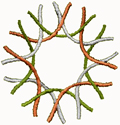 |
GARY C. WILLIAMS Curator of Invertebrate Zoology California Academy of Sciences |
 B.A.,
University of California, Berkeley (1972); M.A., San Francisco State University
(1975); Ph.D., University of Cape Town (1987). Curator of Coelenterates,
South African Museum (1983-89). Chairman, Department of Marine Biology,
South African Museum (1987-89). Scientific Editor, Sagittarius, Natural
History Magazine of the South African Museum (1986-89). Research Associate,
California Academy of Sciences (1987-90). Post-Doctoral Fellow (1990-91).
Assistant Curator (1991-94). Associate Curator (1994-97). Curator (1997-present). Chairman, Department
of Invertebrate Zoology and Geology (1995-98; 2004-2009). Associate Editor, CAS Scientific Publications (2002-2009). Fellow: Linnean Society
of London; California Academy of Sciences. Member: American Association
for the Advancement of Science.
B.A.,
University of California, Berkeley (1972); M.A., San Francisco State University
(1975); Ph.D., University of Cape Town (1987). Curator of Coelenterates,
South African Museum (1983-89). Chairman, Department of Marine Biology,
South African Museum (1987-89). Scientific Editor, Sagittarius, Natural
History Magazine of the South African Museum (1986-89). Research Associate,
California Academy of Sciences (1987-90). Post-Doctoral Fellow (1990-91).
Assistant Curator (1991-94). Associate Curator (1994-97). Curator (1997-present). Chairman, Department
of Invertebrate Zoology and Geology (1995-98; 2004-2009). Associate Editor, CAS Scientific Publications (2002-2009). Fellow: Linnean Society
of London; California Academy of Sciences. Member: American Association
for the Advancement of Science.
A broad interest in natural history developed during childhood, in a relatively uncrowded San Francisco Bay Area - before the enormous influx of human population that extinguished much of the open space and altered the regional biodiversity forever. An early interest in marine life was influenced by two enthusiastic marine biologists - Dr. Gordon Chan (College of Marin Biology Instructor) and Dusty Chivers (Senior Curatorial Assistant in the Academy's Department of Invertebrate Zoology).
My research interests include the systematics of soft corals, gorgonians, and pennatulaceans, as well as the history of research and exploration.
Octocorallian coelenterates include some of the most beautiful and morphologically diverse animals in the world's oceans - these are the soft corals, sea fans, and sea pens. They are a group of corals characterized by having eight feathery tentacles surrounding the mouth of each polyp. Due to a paucity of good characters and the great phenotypic variability of species, octocoral systematics has traditionally been difficult and disputatious - partly explaining why there is a corresponding paucity of octocoral systematists! Other factors that make the field challenging include the extreme difference in appearance between live and preserved material, and the poor attention to detail in much of the older descriptive literature.
My current field research program is focused on coral reefs of the tropical western Pacific, particularly Melanesia, the Philippines, and Micronesia. Other research interests have taken me to the Galapagos Islands, Patagonia, the Gulf of Guinea, Southern Africa, the Russian Far East, Antarctica, and the subarctic. Scuba diving is essential to my field research since the highest diversity of octocorals is found between 5 and 35 meters in depth. Soft corals are most abundant on shallow reef flats, while sea fans are more abundant on slopes and walls. In addition, sea pens are encountered mostly at night in sandy areas.
__________________________________________________________________________________________________
Links
Website: Octocoral Research Center or Octocoral Home Page
Darwin Lecture Video: http://fora.tv/2009/02/17/Gary_Williams_Darwin_in_Southern_South_America#%20
Radio Audio: http://www.calacademy.org/science/sia/2007/10/stinging-seas/
San Francisco State University Research Professor: http://biology.sfsu.edu/content/cas-research-professors
Selected Publications
Williams, G.C. 1993. Coral Reef Octocorals - An Illustrated Guide to the Soft corals, Sea Fans and Sea Pens inhabiting the Coral Reefs of Northern Natal. Durban: Durban Natural Science Museum, 64 pp.
Williams, G.C. 1995. Living genera of sea pens (Coelenterata: Octocorallia: Pennatulacea): illustrated key and synopses. Zoological Journal of the Linnean Society 113: 93-140.
Gosliner T. M., D.W. Behrens, and G. C. Williams. 1996. Coral Reef Animals of the Indo-Pacific - Animal Life from Africa to Hawai'i Exclusive of the Invertebrates. Monterey: Sea Challengers, 314 pp.
Williams, G.C. 1997. Preliminary assessment of the phylogenetics of pennatulacean octocorals, with a reevaluation of Ediacaran frond-like fossils, and a synthesis of the history of evolutionary thought regarding the sea pens. Proceedings of the Sixth International Conference of Coelenterate Biology: 497-509.
Williams, G.C. 1999. Index Pennatulacea: Annotated Bibliography and Indexes of the Sea Pens (Coelenterata: Octocorallia) of the World 1469 - 1999. Proceedings of the California Academy of Sciences 51 (2): 19-103.
Williams, G.C. 2001. First record of a bioluminescent soft coral: description of a disjunct population of Eleutherobia grayi (Thomson and Dean, 1921) from the Solomon Islands, with a review of bioluminescence in the Octocorallia. Proceedings of the California Academy of Sciences 52 (17): 209-255.
Williams, G.C. and P.J. López-González. 2002. A new genus and species of sea pen (Octocorallia:
pennatulacea: Stachyptilidae) from the
Williams, G.C. and O. Breedy. 2004. The Panamic Gorgonian Genus Pacifigorgia (Octocorallia: Gorgoniidae) in the Galapagos Archipelago, with Descriptions of Three New Species. Proceedings of the California Academy of Sciences 55 (3): 55-88.
Williams, G.C. and P.J. Lopez-Gonzalez. 2005. A New Genus and Species of Gorgonian Octocoral (Anthozoa: Plexauridae) from Antarctic Waters. Proceedings of the California Academy of Sciences 56(26): 379-390.
Williams, G.C. 2007. History of Invertebrate Zoology at the California Academy of Sciences. Proceedings of the California Academy of Sciences 58(12): 197-239.
Williams, G.C. 2008. William Dampier - Science, Exploration, and Literary Influence Including his Hydrographic Treatise of 1699. Proceedings of the California Academy of Sciences 59(14): 533-663.
California Academy of Sciences, Golden Gate Park, San Francisco, California
